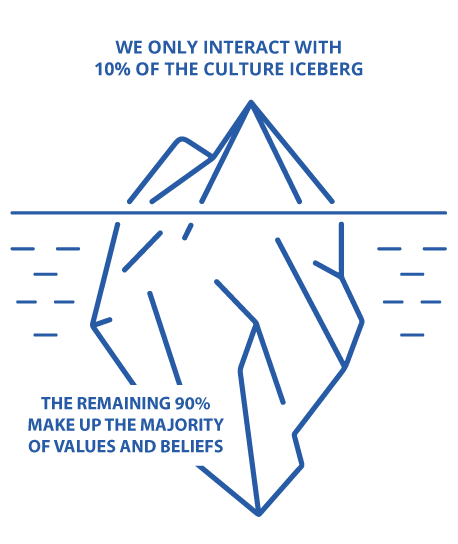Module 1: Creating Intercultural Awareness and Understanding Attitudes
What is Culture?
Culture is a very complex term; there is no single definition that encompasses everything that culture is because it spans every aspect of our lives as social beings. We may hear terms such as organizational culture, team culture, and material culture, and we refer to ancient cultures or the fine arts as culture. However, what does it mean when we talk about belonging to a culture or several cultures? How does this allow us to distinguish cultures around the globe?
Think About This
Take a moment to think about what culture means to you. What do you understand by culture?
If someone asks you to explain what you mean by culture, what would you say?
Activity: Defining Culture
For our purposes, we will understand culture as
“An accumulated pattern of values, beliefs, and behaviours, shared by an identifiable group of people with a common history and verbal and nonverbal symbol systems”
What examples of culture that you listed are included in this definition? Is there something you did not consider?
Culture Iceberg
Anthropologist Edward T. Hall (1976) used a visual representation of an iceberg to create a better understanding of culture and its components. Hall explains that, at the top of the iceberg, there are cultural elements one can perceive with the senses. They are learned or acquired consciously, they can change relatively easily, they can be observed, they are tangible, and one may be able to describe them without having extensive experience in another culture. Conversely, at the bottom of the iceberg, there are elements one cannot perceive with the senses. They are learned or acquired unconsciously, they are hard to change, they are intangible, and one cannot describe and understand them without having extensive experience in another culture.
Watch the video “Cultural Iceberg” (1’51”) that explains Hall’s theory. As you watch, try to think about more examples you would incorporate at the top and bottom of the iceberg.
When we first interact with people from a different cultural background (at home and abroad), we are only interacting with the top 10% of the culture iceberg. That is the tip of the iceberg.

Iceberg by Oleksandr Panasovskyi from NounProject.com and licensed under CC BY 3.0. Colours changed and labels added.
It is common to make assumptions or develop ideas about other cultural groups without really understanding their internal or deep culture. That is, the remaining 90% that makes up the majority of our values and beliefs.
Activity: Culture Iceberg
Look at the words listed below. Each one represents an element of culture. Decide whether they could be expected to be either at the top or bottom of the iceberg based on the descriptions below.
Hall’s Culture Iceberg shows how elements on the surface are visible, palpable, and easier to adapt to or learn. As examples, consider how you have expanded your appreciation of music in a different language or dialect, how you have incorporated foods from other cultures into your regular meals, or how you have read literary works from writers around the globe. This is considerably easy to do while making conscious decisions to observe, try, or participate in a different cultural experience.
However, what happens with the elements at the bottom of the iceberg? As we grow up, we internalize our culture’s way of thinking and being. In addition, we internalize our culture’s values, ways of behaving, attitudes, philosophical concepts, approaches to work and study, ways to understand and forge relationships, family dynamics, how to show respect, and so on. It is here, at the core of our cultural background, that most intercultural misunderstandings take place because we cannot see and understand these elements when we first meet each other.
Only through exposure and openness to cultural learning can we create meaning and understand how these elements are similar or different to our core culture’s ways of thinking, reasoning, behaving, and even feeling, which define what is considered right and wrong within each cultural group.
Think About This
Think about a time when you travelled somewhere and met someone from another culture:
- Were you able to understand everything around you including accents, foods, implicit rules when talking to people, what to do or not to do?
- How did you feel about the things you did not understand?
- How do you think newcomers to Canada may feel about the new surroundings?
- Depending on how familiar they are with Canadian culture, what challenges could they have?
TakeAway Points
- Most intercultural misunderstandings happen because we cannot see the hidden elements of culture, and we start making assumptions and applying our own understanding of right and wrong to other groups.
- Even when we share a common culture, we belong to different groups within the larger group, whether this is the dominant or non-dominant culture in Canada or elsewhere.
- If we focus only on what we see on the surface, we may think that a person who we initially perceive as “different” may, in fact, be more similar to us. However, we can only verify and appreciate this if we learn about others more intentionally.
Try These Strategies
- When you meet people from other cultural groups, do not focus only on learning about food, music, or how to say a few words in their language; pay attention to what seems important for the other person and how they behave so you can learn from that, keeping in mind some of the behaviours are cultural and others are individual/personal.
- Ask questions: take time to learn about people as individuals (their personality) and cultural tendencies. Asking will help you understand others better while learning to avoid making assumptions about them.
Media Attributions
Retrieved from https://thenounproject.com/search/?q=iceberg&i=2258187 and licensed under CC BY 3.0. Colours changed and labels added.

